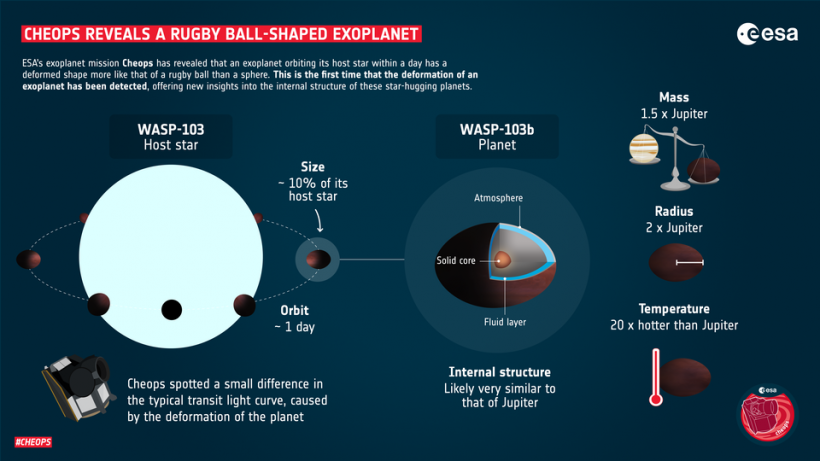Scientists made a major breakthrough when a satellite discovered a planet beyond the Solar System that had been warped by its host star into the shape of a rugby ball, proving that planets are not all spherical.
According to astronomers, WASP-103b is a strange exoplanet orbiting an F-type star that is more massive than our Sun. The planet is also rather huge, roughly one-and-a-half Jupiter's size. The planet's unique form is due to its near closeness to its host star.
WASP-103b is only 20,000 light-years from its parent star, which may generate tidal forces to tug it into an unusual form.
During the ESA's "Cheops" mission (CHaracterising ExOPlanet Satellite), which debuted in late 2019 and started observations in spring 2020, astronomers measured WASP-103b and other exoplanets thoroughly.
Researchers published the conclusions of "Detection of the Tidal Deformation of Wasp-103B at 3 σ With Cheops" based on the NASA/ESA Hubble Space Telescope and NASA's Spitzer Space Telescope.
"Cheops measures exoplanet transits - the dip in light caused when a planet passes in front of its star from our point of view," explains an official writeup for the ESA.
1/ Not all planets are spheres!
Meet WASP-103b, a rugby ball-shaped #exoplanet 🏉
The deformation – caused by strong tidal forces between the planet and its host star – was spotted by #Cheops 👉https://t.co/2gJ7JB70JT pic.twitter.com/23cXlaMtyv— ESA CHEOPS – Characterising Exoplanet Satellite (@ESA_CHEOPS) January 11, 2022
Experts Explain Why Wasp-103b Shaped Like a Rugby Ball
According to Forbes, solid tidal forces between WASP-103b and its host star distort the planet into its rugby ball shape. Scientists determined how much WASP-103b is rocky, gaseous, and water by analyzing how distorted the planet is.
ALSO READ: NASA, Citizen Scientists Discovered Weird Jupiter-Size Exoplanet Hiding in the Universe
They did so by waiting until WASP-103b passed in front of its host star from the CHEOPS telescope's point of view-a process known as a transit-and then measuring how mass is distributed throughout the planet using the transit light curve.
X WASP-103b, on the other hand, remains a mystery. WASP-103b was discovered to have statistics comparable to Jupiter, implying that despite having twice the radius, WASP-103b has a similar core structure.
Scientists assumed WASP-103b had a significant potential for deformation given the exoplanet's close closeness to its sun. It completes one revolution around the host star WASP-103 in less than one Earth day.
Its tides are mighty as a result, effectively changing WASP-103b's bulk. The strange oval exoplanet might conceivably reveal more about similar worlds and how they develop.

ESA’s exoplanet mission Cheops has revealed that an exoplanet orbiting its host star within a day has a deformed shape more like that of a rugby ball than a sphere. This is the first time that the deformation of an exoplanet has been detected, offering new insights into the internal structure of these star-hugging planets.
Exciting Study Ahead For This Weird Planet
According to Mashable, WASP-103b's composition is exciting for two reasons. The exoplanet, for starters, looks to be particularly bloated, which might reveal more about gas giants and their behavior.
Second, "orbital decay" is affected by strong tides. This is the steady shrinking of the distance between celestial bodies. According to stellar physics, WASP-103b should be getting closer and closer to WASP-103, ultimately crashing and being devoured by its host star. WASP-103b, on the other hand, has been observed steadily migrating away from WASP-103 by the ESA.
The team wants to use the James Webb Space Telescope to learn more about WASP-103b's tidal deformation and interior structure, which includes researchers from the Universities of Bern and Geneva as well as the National Centre of Competence in Research (NCCR) PlanetS.
RELATED ARTICLE: ESA Cheops Mission Discovered This Never Been Seen Football Exoplanet That Completes An Orbit In Less Than A Day
Check out more news and information on Space in Science Times.














